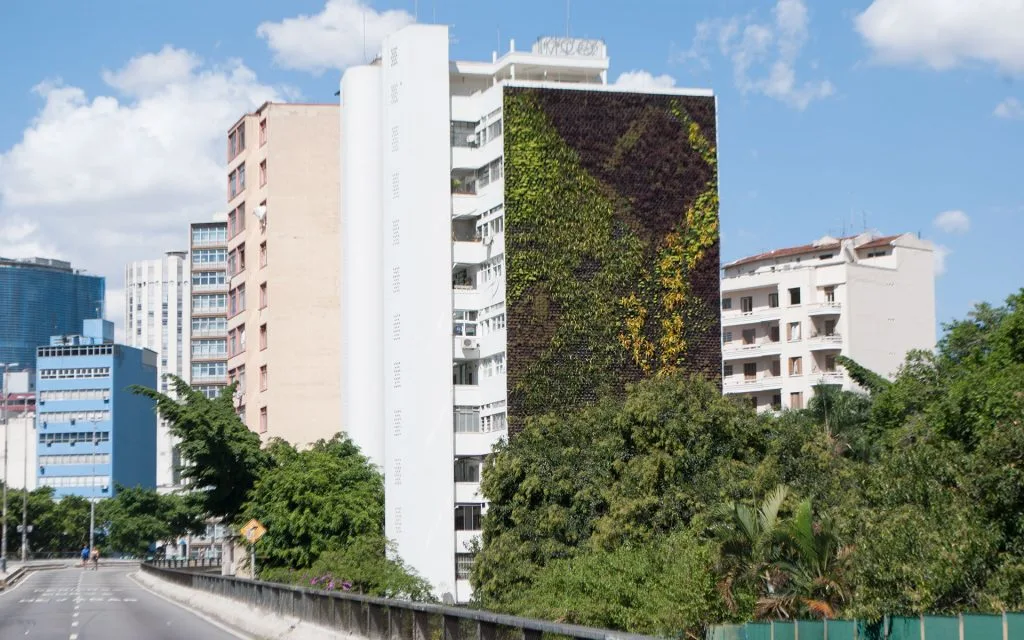

The Brazilian city of São Paulo is a metropolis in every sense of the word. Home to 32 million people, it’s a vibrant, chaotic, energetic, colorful, noisy city. Green space is at a premium (it has just one-sixth of the UN’s recommended ratio of green space per resident).
Guil Blanche, a 26-year-old landscape artist, decided that a creative use of the city infrastructure might just be the best way to tackle some of these problems. Inspired by vertical gardens (one of the most interesting architectural trends of recent years), and in particular the work off French artist Patrick Blanc, Guil reimagined this phenomenon in a specifically São Paulo context, using affordable materials and taking over the city’s empty facades.
The plants improve air quality by filtering CO2, can help with heating and cooling in the buildings they are attached to, reduce acoustic problems and, during periods of drought, increase the relative humidity in the air. But to add an extra creative spin, Guils’ studio Movimento 90º invited artists to design the gardens they were creating, and encouraged them to treat the buildings’ walls as blank canvasses.
We spoke to Guil about how his ambitious project came into being…

How did you come up with the idea for Movimento 90º?
I studied architecture, fine arts and landscape design and believe these three areas allowed me to conceive the overall idea for Movimento 90º. The work of Patrick Blanc, inventor of the vertical garden, was very inspiring for me and as I studied it, I realized it was way too expensive to be used on a large scale in Brazil. So I started to develop my own technique, based on Patrick’s, but using cheaper materials such as recycled impermeable plates combined with locally produced high density felt all in a modular format, which made the technique more adaptable to Brazil’s environment and to its budget.
Movimento 90º started as a manifesto, a call to occupy the numerous blind façades around São Paulo with much-needed green areas. I assembled a small team, and we started to map out the blind façades around São Paulo, starting from the centre, the area which needed green areas the most. In the end we managed to gather around 260,000m2 of potential green area for the city.
And then? How did this single idea evolve into the large scale project that it is today?
After we wrote the manifesto, a well-known journalist embraced the cause and decided to help us find support to implement our vertical gardens on a public scale. We knew all we had to do was launch a pilot in order to show people what potential this project had to transform the city. So we managed to find a corporate supporter who hired us to install our first urban scale vertical garden in the Minhocão, the area that interested us the most and where we always had envisioned the world’s first green corridor. The project was a huge success and as a result we had loads of attention from the local papers, including the cover of the Sunday edition of the biggest newspaper in São Paulo. This cover story led to a phone call from the mayor of São Paulo, who had read the story and wanted to meet me so that we could find a way in which to build the world’s first green corridor in the Minhocão!

Why did you choose to work with actual artists for the design of the vertical gardens, instead of – the perhaps more straightforward choice of – landscape architects?
When we thought about the space that we were working with – a blind facade – we thought it would be an amazing space for an artist to come up with a project, to show their work on a scale that they were not used to. This way we were able to merge an artistic approach together with landscaping knowledge – as most artists have never worked with plants before – giving the population not only a garden but also contemporary art and something to reflect upon.
Which kind of selection criteria did you set up for choosing artists? Why did you think the selected artists were a good fit to design the vertical gardens?
We selected artists that we thought had a special relationship with their research and the project. So Daniel Steegmann for example works a lot with the issue of the Amazon and its native plants, Renata De Bonis is an artist worried about the landscape and geology and so on. This way we thought they would embrace the idea as well as have good thoughts on the space, respecting the surroundings and the city.




